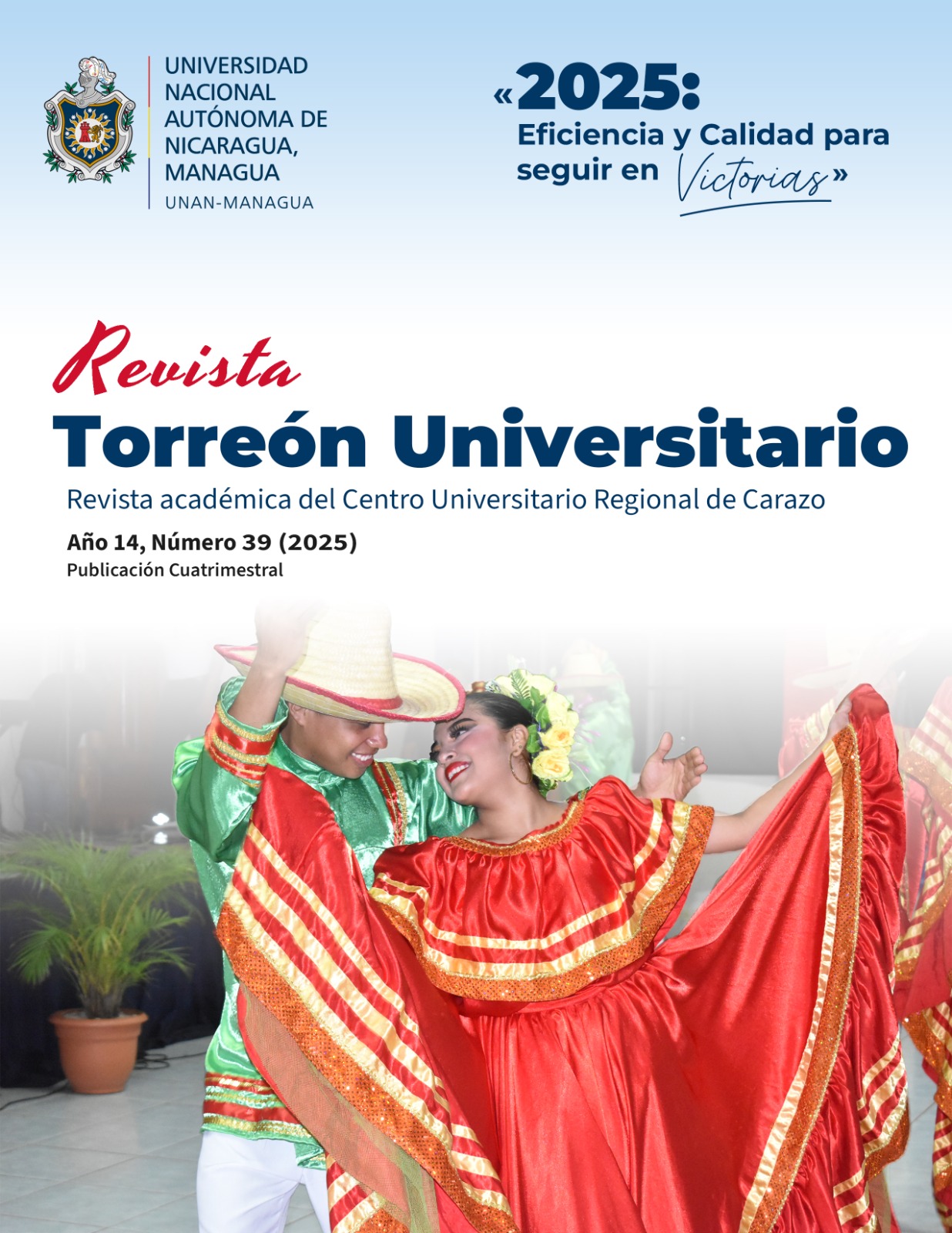Moodle virtual platform as a support tool in secondary education
DOI:
https://doi.org/10.5377/rtu.v14i39.20044Keywords:
Moodle virtual platform, virtual pedagogical counseling, technological and human resources, technological competencies in teachers and studentsAbstract
In this work, a proposal was made for the implementation of a virtual learning platform as a support tool in secondary education. A non-experimental cross-sectional design with a qualitative approach was applied. The instruments used were interviews containing open-ended questions on the state of technological resources and digital competencies of teachers. An analysis was made to know the current situation of the Colegio Sagrado Corazón de Jesús Bethlemitas and to identify the technical requirements and technological competencies of teachers necessary for the implementation of the Moodle virtual platform. As a result, the school, although it has a computer lab, does not have computer resources for the installation and management of the Moodle platform. In addition, the office automation requirements necessary for the implementation of the Moodle virtual platform, human and technological resources are indicated. From the results obtained, it is concluded that for the implementation of the Moodle virtual platform, the infrastructure of technological equipment and a designated staff for the updating and configuration of the computer service of the virtual platform must be guaranteed. In addition to a designated staff for teacher counseling.
Downloads
References
Cacheiro González, M., Sánchez Romero, C., & González Lorenzo, J. (2016). Recursos tecnológicos en contextos educativos. UNED.https://books.google.es/books?hl=es&lr=&id=8BGcCwAAQBAJ& oi=fnd&pg=PP1&dq=recursos+ tecnolog %C3%ADco+en+los+centros +educativos&ots=l70uLLQPED&sig=IO irJbnQivXQy5S65iu5vWAXPD s#v=onepage&q=recursos%20tecnolog%C3%ADco%20en%20los%20centros%20educativos&f=false
Coll Morales, F., & López José Francisco. (2020). Características del estudio transversal. https://economipedia.com/definiciones/estudio-transversal.html
Díaz de la Guardia, J., Martínez Sola, T., & Trujillo Torres, J. (2015). Posibilidades didácticas de las herramientas Moodle para producción de cursos y materiales educativos. Digital Education Review, 28, 62.
Farrach Úbeda, G. (2018). Virtualización de programas de asignatura en la FAREM-Estelí, UNAN-Managua. Revista Científica de FAREM-Estelí(26), 65-75. https://www.camjol.info/index.php/FAREM/article/view/6429/6181
Fernández, L. (2022). Balanceadores de Carga: Así puedes mejorar el rendimiento de tu web. Redes Zone. https://www.redeszone.net/tutoriales/servidores/balanceador-carga-load-balancer-que-es-funcionamiento/
Gabino, V. (2017). RECURSOS EDUCATIVOS DIDÁCTICOS EN EL PROCESO ENSEÑANAZA APRENDIZAJE. Vuadernos, 58(1), 117-129. http://www.scielo.org.bo/pdf/chc/v58n1/v58n1_a11.pdf
Guevara Alban, G., Verdesoto Arguello, A., & Castro Molina, N. (2020). Metodologías de investigación educativa (descriptivas, experimentales, participativas, y de investigación-acción). Revista Científica Mundo de la Investigación y el Conocimiento, 1(1), 75-90. https://recimundo.com/index.php/es/article/view/860
Hernández Sampieri, R., Fernández Collado, C., & Baptista Lucio, M. (2014). Metodología de la Investigación. McGraw-Hill.
Hernandez, C., Gamboa, A., & Ayala, E. (2014). COMPETENCIAS TIC PARA LOS DOCENTES DE EDUCACON SUPERIOR. (ResearchGate, Ed.) In Congreso Iberoamericano de Ciencia, Tecnología, Innovación y Educación, 12, P. 13.
Herrera, A. (2023). ¿Cómo convertir tu curso presencial a uno virtual? innovación y cualificación. https://www.innovacionycualificacion.com/contenidos-elearning/como-convertir-curso-presencial-virtual/
Isaacs, D. (2007). La estructuración de los recursos humanos en los centros educativos. 43(1), 105-120.
Jazcar Bravo. (2014). Virtualización y alta disponibilidad: Una Estrategia De Recuperación Ante Desastres Para la Dirección TIC De La UNAN-Managua. https://repositorio.unan. edu.ni/2382/1/VIRTUALIZACI%25C3%2593N%2520 Y%2520ALTA%2520DISPONIBILIDAD %2520RESUMEN.pdf
López Bueno, H., Val, S., & Gaeta, M. (2023). Importancia de la Digitalización Docente para una Educación Inclusiva, Crítica y Equitativa. Revista Iberoamericana de Educación y Justicia Social, 12(1), 1-14. https://revistas.uam.es/riejs/article/view/riejs2023_12_1_012/16163
López, L., Morales, M., & Navarro Ivonnis. (2021). La Gestión de Recursos Humanos en el Sector Educativo y su Impacto en el Desarrollo Profesional Docente: Una Revisión Sistemática. 6(4), 213-225. https://ciencialatina.org/index.php/cienciala/article/view/7632/11575
Monje, C. (2011). Metodología de la investigación cuantitativa y cualitativa. https://www.uv.mx/rmipe/files/2017/02/Guia-didactica-metodologia-de-la-investigacion.pdf
Moodle Documentation. (s.f). Instalación de Moodle. Moodle Documentation. https://docs.moodle.org/all/es/34/Instalaci%C3%B3n_de_Moodle#:~
Moodle.org. (15 de Enero de 2022).
Morales, P. (2009). Tipos de variables. Estadística aplicada a las Ciencias Sociales. https://gc.scalahed.com/recursos/files/r161r/w25398w/S3_tiposdevariables_SI.pdf
Otzen, T., & Manterola, C. (2017). Técnicas de Muestreo sobre una Población a Estudio. Estudios Pedagógicos, 43(1), 37-52.
Ramirez, D., & González, A. (2011). Modelo de acción docente para el desarrollo de prácticas pedagógicas con medios informáticos y telemáticos en el contexto aula. Universitas Tarraconensis Revista de Ciències de l Educación ·.
Servokiv, A. (2023). ¿Cuáles son las competencias digitales que necesita un docente del siglo XXI? https://nive.la/competencias-digitales-profesores/
Vignolo, A., & Joffre, A. (2018). Solución Práctica para Réplica Asincrónica y Auditoría de Bases de Datos. Argentina.
Wiley , J., & Sons. (2013). Seguridad para la nube y la virtualización For Dummies. New Jersey: Trend Micro.
Downloads
Published
Issue
Section
License
Copyright (c) 2025 National Autonomous University of Nicaragua, Managua

This work is licensed under a Creative Commons Attribution-NonCommercial-NoDerivatives 4.0 International License.
The authors who publish in this journal agree to the following terms.
- The author or authors of the articles, essays or research grant the National Autonomous University of Nicaragua, Managua (UNAN-Managua) the editing rights (copyright) of the submitted work, therefore the University has the exclusive right to publish the article for the entire copyright period.
- These copyrights/authors authorize Torreón Universitario Magazine and the University to edit and disseminate/publish the article in said Magazine, including printed and electronic reproduction, storage, retrieval and any other type of publication, and sources of secondary information as services. of summaries and databases, they also empower it to protect the article against unauthorized use for dissemination by printed or electronic media (PDF, HTML, EPUB, XML or others).
License for use of content
The magazine uses the Creative Commons Attribution-NonCommercial-NoDerivs 4.0 International License.
Under this statement:

This journal is licensed under a Creative Commons Attribution-NonCommercial-NoDerivatives 4.0 International License. It can be copied, distributed and transmitted publicly as long as the author and source are cited (Revista Torreón Universitario), it should not be modified or used for any commercial purpose. The full license can be found at http://creativecommons.org/licenses/by-nc-nd/4.0/.



